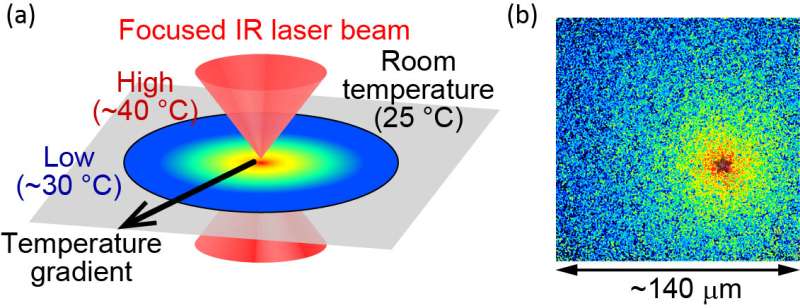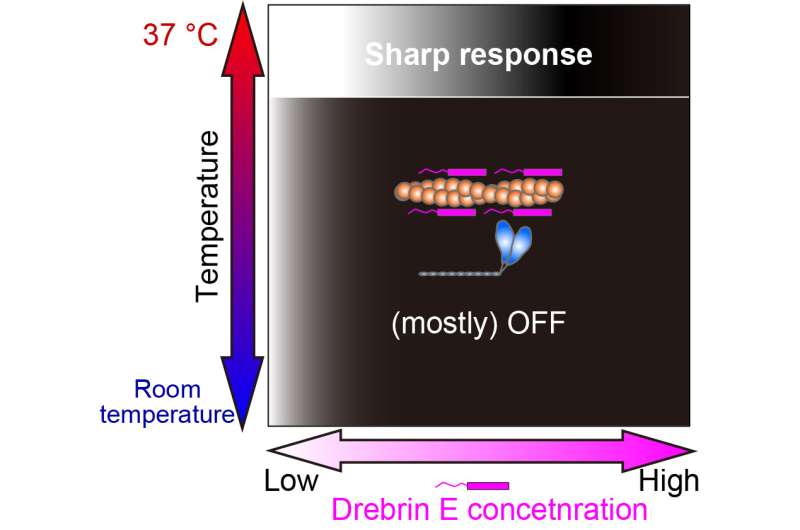
One degree celsius can make a difference: a team of investigators led by Osaka University has demonstrated regulation of a critical protein complex that occurs only at physiological temperature.
To study the functions of proteins, investigators examine purified proteins in vitro. Such experiments are generally limited to temperatures below physiological temperature to prevent thermal damage to the proteins. The team has overcome this problem by applying optically controlled heating with a pulsed infrared laser. “With this method, proteins can be heated up to 40 degrees Celsius without any damage to the proteins,” says lead author Hiroaki Kubota, “which enables us to examine how proteins act at their physiological temperature.”
The investigators applied this heating method to study the actomyosin complex. Actomyosin force generation, which results from the interaction between myosin molecular motors and actin filaments, is a crucial process governing cell motility and morphology. The protein drebrin E has been shown to inhibit these interactions, but its mechanism of regulation is unclear. To clarify the role of drebrin E, the team applied microscopic heating to actomyosin in the presence of drebrin and observed the motility produced by actomyosin force generation over a range from room temperature to physiological temperature.
The researchers found that the inhibition of actomyosin motility by drebrin E is eliminated immediately and reversibly during heating, depending on the drebrin E concentration. As the temperature increases, the inhibition of actomyosin motility by drebrin E decreases. The team also found that the reduced inhibition is not solely caused by dissociation of drebrin E from actin. Instead, bound drebrin E cooperatively regulates actomyosin activity likely by altering the actin structure.

Interestingly, below physiological temperature, the actomyosin motility shows a gradual decay with increasing drebrin E concentration. Yet, at 36.5 degrees Celsius to 37.5 degrees Celsius, the behavior changes, and drebrin E exhibits a switch-type behavior of inhibition. The motility is unaffected by the drebrin E concentration until a threshold is reached, which immediately results in inhibition. Their findings suggest that the threshold concentration is similar to previously reported physiological drebrin E concentrations.

This temperature-dependent regulation of drebrin E is remarkable and has many implications for future studies. “These results suggest the importance for pregnant mammals to maintain the appropriate body temperature to ensure precise development of an embryo,” says Madoka Suzuki, senior author. Furthermore, gaining a precise understanding of the mechanisms of cellular temperature-sensing machinery, we may be able to innovate the development of artificial nanoscale temperature sensors.
The article, “Microscopic temperature control reveals cooperative regulation of actin–myosin interaction by drebrin E” was published in Nano Letters.
More information:
“Microscopic temperature control reveals cooperative regulation of actin–myosin interaction by drebrin E” Nano Letters (2021). DOI: 10.1021/acs.nanolett.1c02955
Journal information:Nano Letters
Provided by
Osaka University

READ MORE
How Online Banks Work
Online banks are the wave of the future. See more banking pictures. Jack Hollingsworth/Getty Images [...]
15 Seemingly Simple Questions We Don’t Know the Answer To
Science, mathematics, and technology have answered so many thoughts and questions. But it may sound [...]
Graphene-coated face masks: COVID-19 miracle or another health risk?
Credit: Pixabay/CC0 Public Domain As a COVID-19 and medical device researcher, I understand the importance [...]
Heat-resistant nanophotonic material could help turn heat into electricity
Microscopy images show no discernible degradation before and after heat treating the material. Credit: Andrej [...]
In a First, Cheetah Cubs Born Through Surrogacy at the Columbus Zoo
The first two cheetah cubs born via embryo transfer Courtesy of Grahm S. Jones, Columbus [...]
X-photon 3D nanolithography
3D resolution bridge (RB) printing and line analysis. (a) Illustration of GDD pre-compensated pulses propagating [...]
Why Is Biodiversity Important for Ecosystems?
These cheetahs don’t have many options when it comes to breeding mates. Serious inbreeding has [...]
Cyborg technology analyzes the functional maturation of stem-cell derived heart tissue
The nanoelectronic sensors (yellow, blue) are embedded with natural tissues (red, green). Credit: Liu Lab, [...]